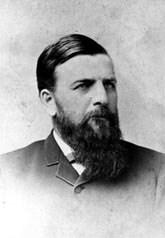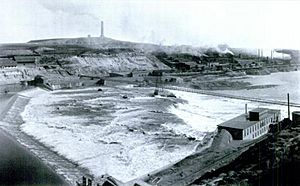Boston and Montana Consolidated Copper and Silver Mining Company facts for kids
| Public company | |
| Industry | Mining, smelting, refining |
| Successor | Amalgamated Copper Company |
| Founded | 1887 |
| Defunct | 1901 |
| Headquarters | Butte, Montana |
|
Area served
|
United States |
The Boston and Montana Consolidated Copper and Silver Mining Company (often called "Boston and Montana" or "B&M") was a big company in the United States. It focused on mining, smelting (melting ore to get metal), and refining (making metal pure). Most of its work happened in Montana.
The company started in 1887. It later joined with the Amalgamated Copper Company in 1901. Amalgamated Copper Company became Anaconda Copper in 1910. This new company grew into one of America's largest businesses. Historian Michael P. Malone said the Boston and Montana was "well financed and well managed." It became one of the world's top copper companies.
Contents
How the Company Started
Adolph and Leonard Lewisohn were brothers from Germany. Their father started a company called Lewisohn Brothers in 1858. This company bought and sold different materials. In 1867, Adolph and Leonard moved to the U.S. and took over the family business. They started to focus on trading metals like copper, lead, and zinc.
In 1879, the brothers had a chance to buy mines in Arizona, Montana, and Tennessee. They used $75,000 to create new companies. These included the Montana Copper Company. In 1887, the Lewisohn brothers bought Lewisohn Brothers from their father. They made it an independent company.
The Boston and Montana company officially began on July 22, 1887. It was formed by combining Lewisohn Brothers, the Montana Copper Company, and mines owned by C. X. Larrabee. Larrabee owned famous mines like the Larrabee and Mountain View.
The B&M quickly became the second-largest company in Montana. Only the Anaconda Copper Company in Butte was bigger. The Boston and Montana owned mines in Arizona, Michigan, Montana, and Tennessee. For many years, "Captain" Thomas Couch, an expert miner, managed the company.
Why Great Falls?
In Montana, the B&M got a lot of copper from its Leonard and Colusa mines near Butte. The company had a small smelter in Meaderville. But this smelter was too small for all the ore. A new, larger smelter needed cheap power and lots of water. Leonard Lewisohn thought about building it in either Helena or Great Falls.
Great Falls was chosen for a few key reasons.
- First, there was a railroad to Great Falls. James J. Hill, who ran the Great Northern Railway, had built a line called the Montana Central Railway. This railway connected Great Falls with Helena and Butte. It helped move metals to market and bring coal to the smelters.
- Second, James J. Hill had invested a lot in Great Falls. He started the Great Falls Water Power & Townsite Company in 1887. His goal was to develop the city and attract businesses. He offered low shipping costs on his railway. He also gave Leonard Lewisohn 1,500 shares in his power company. This was a big incentive.
On September 12, 1889, the Boston and Montana made a deal. The power company agreed to build a dam to provide power for the smelter. In return, Boston and Montana agreed to build a copper smelter costing $300,000. Black Eagle Dam started making electricity in December 1890.
Building the Smelter
Construction on the new smelter began in the spring of 1890. It was built on a hill near Black Eagle Dam, next to the small town of Black Eagle, Montana. Different parts of the smelter opened over time:
- The concentrator (which separates ore) opened in March 1891.
- Furnaces for melting ore opened in April 1892.
- Converters (for making copper purer) opened in August 1892.
- Refining furnaces and an electrolytic refinery (using electricity to purify metal) opened in early 1893.
- Blast furnaces (for very high heat) opened in April 1893.
The original smelter cost $2 million to build. By 1892, more than 1,000 people worked there.
In the early 1890s, the Boston and Montana was one of the most powerful mining and refining companies in Montana. Other big companies included Anaconda Copper. In 1890, half of all copper mined in the U.S. came from Montana. By 1897, the Boston and Montana produced 60 million pounds (about 27 million kg) of copper.
Joining Amalgamated Copper
In 1899, a businessman named Henry Huttleston Rogers wanted to create a huge copper company. He planned to combine many smaller companies. He bought Anaconda Copper in 1899. Then, he created a new company called the Amalgamated Copper Company. This company would control Anaconda and other firms.
By November 1900, Amalgamated had bought several other companies. The next year, Rogers gained control of the Boston and Montana company. This meant the B&M became part of the much larger Amalgamated Copper Company.
After the Merger
The former Boston and Montana smelter in Great Falls became famous for its "Big Stack." This was a very tall chimney built to release fumes. Construction began on April 7, 1908. It was 506 feet (154 meters) high. When it was finished on October 23, 1908, it was the tallest chimney in the world.
The old Boston and Montana smelter in Great Falls closed in 1980.
In 2011, the United States Environmental Protection Agency (EPA) listed the old B&M smelter site as a Superfund site. This means it's a hazardous waste site that needs cleaning up. The EPA found that plant wastes were often dumped into the Missouri River. These wastes included heavy metals like arsenic, cadmium, copper, and lead. These toxins could spread far downstream.
|



